Deborah Silver is an accomplished and experienced landscape and garden designer whose firm first opened its doors in 1986.
I am not a cook. I am not especially fussy about what I eat. I like grilled cheese sandwiches and tomato soup. I am happy with a tunafish sandwich, or a burger. I like whatever Buck fixes. Milo and Howard have eaten the same brand of kibble every day for 7 years-I am just about there. I do on occasion long for some liver and onions, or Chinese food for a local and great restaurant, but day to day, I am a food bore. Feed me please-I need to get that meal over with, and get going. I eat to live, not to be entertained.
But I really like fresh vegetables-why? I grew up with that. My Dad shopped for fresh vegetables and fruits-we always had them. At least three, every meal. A sample vegetable menu-home grown potatoes, spinach, and salad. Or broccoli, corn, and tomatoes. I like salad, every day. On those days when Buck is too tired to fix one, I am happy with a wedge of iceberg lettuce-as long as it is fresh. At this time of year, Buck and I eat good greens every day. Swiss chard-a favorite. Turnip or beet greens-a close second. Bok Choy, brussel sprouts, kale, beet greens, spinach, okra-we chow down all of the fresh greens.
Buck really likes to cook. He watches cooking programs on cable. I and happy to join him. This is the least I can do, considering that he shops weekly, and goes on to feed me every day. Every program we watch emphasizes the importance of cooking with great materials. Fresh greens. Locally grown produce. Every program he watches has a common thread-the importance of good ingredients.
What I cook up in the landscape no one can eat, but anyone can see. It is tough to make a beautiful landscape with poorly grown shrubs, or park grade trees. Well grown perennials take hold quickly, and thrive. Beautiful fresh flowers are easy to arrange. Preserved eucalpytus has this going for it-the preservation part enables an arrangement that lasts a long time.
I have lined many a wire container with florist’s moss. This raw material comes in varying thicknesses, and highly variable dimensions. Moss rolls- his new product transforms the bits and pieces that I recognize as florist’s moss into sheets that are easy to work with. How I love this good ingredient! I could wallpaper a room with it.
The good ingredients for holiday and winter pots are many. A wide range of choices in materials means a wide range of expression is possible.
Cut noble fir is a really great ingredient. Versatile and very long lasting.
These double ball topiary sculptures-I made them for a client in 2005. What you see here-a new, and fresh layer of dried moss. Good materials are visually fresh. This moss looks good enough to eat.
Our first shipment of magnolia came today. Magnolia makes great wreaths and garlands. The cut branches are mouthwatering good in winter containers.
You are halfway home in any holiday decor project, assembling some good materials.
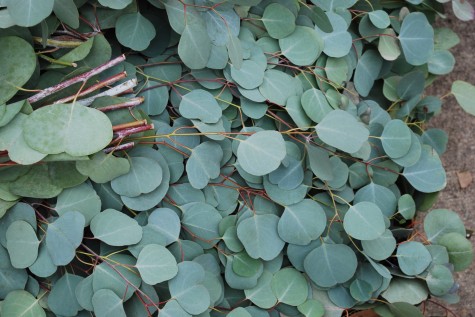 Should you take the time to represent the season, use good ingredients. There are lots of places to find them, including your own yard, a field down the street, the farmers market, your local nursery, a local fruit market, the grocery store, I shop for good ingredients in all of these places-not just my own.
Should you take the time to represent the season, use good ingredients. There are lots of places to find them, including your own yard, a field down the street, the farmers market, your local nursery, a local fruit market, the grocery store, I shop for good ingredients in all of these places-not just my own.
So many of the materials used at the holidays are harvested from the landscape. Not my landscape, mind you. My evergreens grow much too slowly to be trimmed for holiday greens; the one spruce on my property was limbed up at least 12 feet before I moved in. But there are places where the boxwood flushes several times a season, and the magnolia grows lushly. Thank heavens for all the fir-Noble, Frazier, Douglas, Balsam, Silver, Concolor-fir boughs are so beautiful, long lasting, and fragrant at the holidays. And of course, the iconic boxwood. Cut magnolia-this a a subject worthy of a post soon to come. We have true variegated English boxwood branches for the first time this season. Would that I could grow this gorgeous evergreen in my garden! That aside, I plan to enjoy all of the cut greens available during the holiday and winter season.
Noble fir-so aptly named. The short needles grow densely along each branch. They shrug off the worst of the winter weather; the cut branches stay green for months. Evergreen needles have evolved to survive long periods when the roots cannot obtain water, when the soil is frozen. The needles have very little in the way of surface area. This means water evaporates at a lower and slower rate than say a maple leaf. A big surface area means rapid evaporation. Their formal shape and gorgeous blue green color makes them a green of choice for winter arrangements. Noble fir-the mainstay of my winter container arrangements.
Berried juniper is not my most favorite green, but the blue berries are very persistent. I like mixing this green with other blue hued greens.
Long needle pine-just exactly what species is this? This is not a common name that I know. Should you recognize this evergreen, will you write me? The long needled pines-as in white pine, have gracefully curving stems. This makes them great for informal arrangements. Curvy is a good look, for the winter.
I love the texture and the fragrance of cedar. This is an evergreen with flat needles. Those flat needles present more surface area to all of those elements that dry out cut greens. I use Port Orford cedar, a lax and luscious variety distantly related to my thujas, outside only. Cedar roping and branches dry out very quickly indoors. Even outdoors, they dry, brown out, and drop needles too soon to make them a cut green of choice. I use cedar as an accent in my holiday decor projects. Long lasting gets lots of votes. That aside, I like any seasonalexpression. Cut cedar for that one moment brings the holidays to mind. Cedar branches-so fragrant, and so fleeting.
Douglas fir is perhaps the least showy of all of the specialty holiday greens, but its longevity is legendary. I have been known to cut up Douglas fir Christmas trees after Christmas for winter pots. Douglas fir will stay green well into April. I am impressed by this. 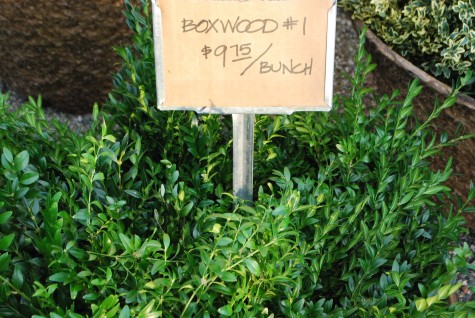
Boxwood is an evergreen so close to my heart-I like them wild, I love them trimmed. Broad leaved evergreens are a great foil to the needled evergreens. This is the perfect cut material for clipped topiaries, and formal wreaths. Any arrangement of needled evergreen boughs gets a visual boost from any boxwood companionship. I like the reference in my holiday decor to the boxwood in my garden.
Princess pine-I have never planted one. I do not know the species. But these branches look great in winter containers and garlands. The long needles are presented in short tufts. Where would this work for you?
German boxwood is a very big leaved boxwood. The very large leaved branches are striking in winter or holiday arrangements.
Oregonia is a name of choice in the florist trade for boxwood-but this boxwood is much more subtle, and smaller leaved than our English variegated boxwood. I will not debate the differences. I can only say that there are so many choices in cut greens for the holidays.
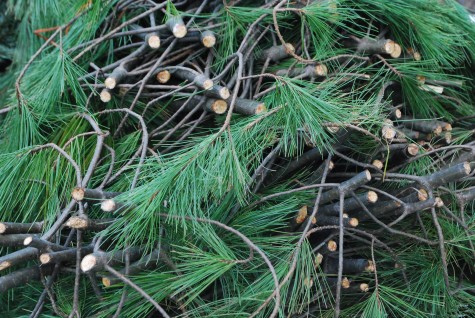
Every bale of greens that came in this week -beautiful. Those fresh materials-they smell great. I hold them in my hands, and imagine. They keep me going. They keep me going strong.
How long will it last? This question is asked of me many times over the course of the gardening season. The questions come in many forms. The summer season is so short-can I plant my annuals the beginning of May? How long will the annual plants bloom? What perennials bloom all summer long? What perennials bloom the longest? Which varieties of tulips are perennial? How long will this magnolia bloom ? What trees bloom all summer long? How can I have color in my perennial garden every day? How long will my Becky shasta daisies live? How long do fiber pots last-can I keep them for more than one season? How long will a fall planting last? You get the idea. Pictured above is the holiday wreath that I made for my front door-last year. How long did it last?
I put my holiday wreath in the basement in late February, as I am reluctant to let go of the holiday season. I brought it to work, and and photographed it on my office door a week ago. The best part of saving it was Rob’s reaction when he got to work. He thought maybe I was making a critical statement about his dried weed arrangements. That was not at all on my mind. This picture just answers the question. Many things in the garden are ephemeral.
Last year’s winter display in front of the shop took into consideration that I wanted it to last the winter. The branches were fresh cut; I knew they would last. The glass ornaments I prepared as best I could. Each one had its metal cap glued on. Enough glue was used such that the air holes in the caps were completely filled. The day the shop decor was finished, every element looked fresh.
Michigan winters dish out a lot in the way of stormy weather. Wind, snow and cold take their toll on everything in the landscape. The burlap drapes and pot wraps shrugged off every insult. But by late February, the ornaments were beginning to loose their shine.
The ornaments began to fade; the ornament in the center of this picture has taken on a distinctly orange cast. Did I mind this? No. The branches arranged to look like trees looked like they were loaded with berries. In March we had red, orange, and silver berries-where the color coating had worn off all together. How long did it last? As long as it needed to. 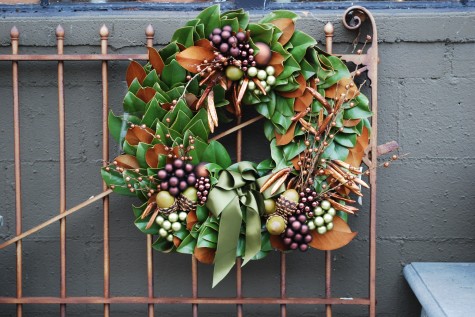
Fresh magnolia leaves are a rich and shiny green on the top side, and a velvety chocolate brown on the obverse. Magnolia wreaths are beautiful at the holidays; I love the big texture and great color. How long does magnolia stay fresh? Magnolia kept cold, but not freezing, will stay fresh a long time. What does a long time mean? The length of the holiday season. Subjected to very cold temperatures outside, the leaves will develop freeze spots, but we rarely have temperatures in the low 20’s during December.
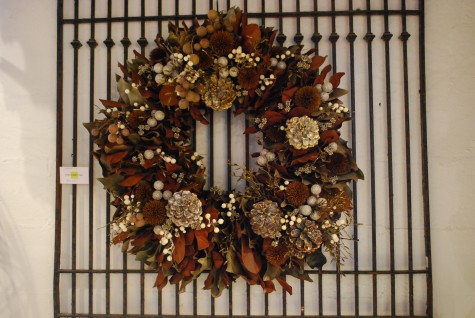
How long does magnolia last? This wreath was a year old when I sold it. It had never been hung outdoors. Magnolia leaves dry beautifully to a pale platinum green. The undersides if the leaves fade some in the drying process. A magnolia wreath can be kept a long time, provided that great care is taken in the handling. The leaves are very brittle when dry, and snap easily. Storing them in tissue paper in a somewhat cool location will prolong their life. Magnolia garland and wreaths outdoors will begin to look very tired the end of February. If you have a covered porch, they might last well into March.
I cut the elegant feather grass that grew in the roof window boxes all summer, and laid it out to dry. Will it last? I have no idea; this is an experiment. The willingness to experiment can produce some startling results-we’ll see what happens with this. But I know not to ask too much. If it lasts until New Year’s, I will feel like it has given enough.
This boltonia is from my rose garden. I am drying this, and my Japanese anemone as well. What are my plans for this material? I’ll take pictures.
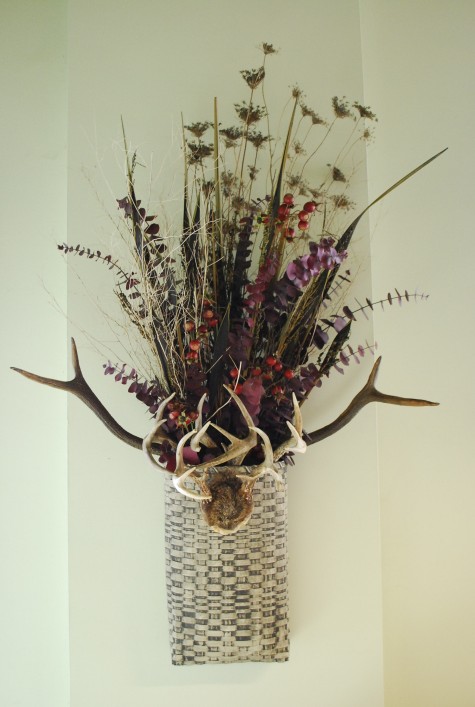
I made this arrangement for a client, using her metal basketweave wall hung container, and her collection of horns. The arrangement is composed of faux rose hips, dried Queen Anne’s Lace, some unknown weeds, preserved and dried eucalyptus, and preserved bahia spears. 4 of her antlers are wired inside the container; the fifth was glued on to the surface of the container. I like taking materials that belong to and mean something to a client, and creating something that makes beautiful use of them. How long will this last? Long enough for her to tire of it, and think about a new look. No small part of the beauty of the garden, and the beauty of the season, is its ephemeral nature. This is just cause for celebration.
Deborah Silver is a landscape and garden designer whose firm, Deborah Silver and Co Inc, opened its doors in 1986. She opened Detroit Garden Works, a retail store devoted to fine and unusual garden ornament and specialty plants, in 1996. In 2004, she opened the Branch studio, a subsidiary of the landscape company which designs and manufactures garden ornament in a variety of media. Though her formal education is in English literature and biology, she worked as a fine artist in watercolor and pastel from 1972-1983. A job in a nursery, to help support herself as an artist in the early 80’s evolved into a career in landscape and garden design. Her landscape design and installation projects combine a thorough knowledge of horticulture with an artist’s eye for design. Her three companies provide a wide range of products and services to the serious gardener. She has been writing this journal style blog since April of 2009.
Copyright © 2024 · Deborah Silver & Co. · Detroit Garden Works